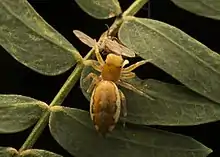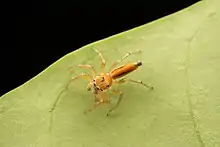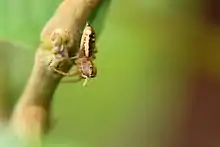Cosmophasis lami
Cosmophasis lami, also known as the Lami Beach northern jumping spider or tangerine garden jumper,[1] is a species of jumping spider in the genus Cosmophasis, probably native to South East Asia and some pacific islands, and possibly introduced to Japan and Okinawa Islands by humans.[2] It was first described by Berry, Beatty & Prószynski in 1997 and has one synonym, Cosmophasis squamata (Saaristo,2002)[nb 1][3][4][5] Both the female and the male have been described.
| Cosmophasis lami | |
|---|---|
 | |
| Female with prey | |
 | |
| Male C. lami | |
| Scientific classification | |
| Domain: | Eukaryota |
| Kingdom: | Animalia |
| Phylum: | Arthropoda |
| Subphylum: | Chelicerata |
| Class: | Arachnida |
| Order: | Araneae |
| Infraorder: | Araneomorphae |
| Family: | Salticidae |
| Subfamily: | Salticinae |
| Genus: | Cosmophasis |
| Species: | C. lami |
| Binomial name | |
| Cosmophasis lami Berry, Beatty & Prószyński, 1997 | |
| Synonyms | |
| |
Description
Exact description may vary, but the species displays sexual dimorphism, with females' coloration being more vibrant. Adult C. lami's carapace is orange-brown.[6] a dark-brown area around the eyes, and coated in orange hairs and the clypeus is orange-brown. The males are coated in orange hairs, cephalothorax are dull orange, abdomen is orange and slender, clypeus orange-brown, black apex and spinnerets and a dark-brown area around the eyes.[3][7] Females are almost similar, with the only difference being a grayish brown sternum and different abdominal markings.[3] It is similar to C. hortoni, but is smaller, the chelicerae shorter, with a longer embolus of the male palp, which is southeast from the bulb.[8]
There is a iridescencent morph.[9]

Etymology
The first recorded specimen of C. lami is a male collected on 3 May 1987 by Joseph Beatty and E.R. Berry from Fiji on shrub foliage in Lami, Fiji and the species was named after it (the location). The name was first published in January 1997 along with Ascyltus similis, Ascyltus rhizophora, Bavia fedor, Bavia sonsorol, Cosmophasis arborea, Cosmophasis muralis, Flacillula nitens, Ligurra opelli, Thorelliola dumicola, and Trite ponapensis.[10]
Distribution
Considered the most widely distributed salticid from Cosmophasis, Cosmophasis lami was first observed in Fiji and is native to South East Asia, Philippines,[11] Cocos Islands, Mauritius, and the Marquesas Islands.[2][10][12][13] The World Spider Catalog says that it is introduced to Seychelles, Marquesas Island, Society Islands, Fiji, and Hawaii.[5] In 2013, it was first recorded in Japan by Tatsumi Suguro.[3] Eight years later, it was recorded in Okinawa Island on roadside vegetation in an residential area, probably by artificial introduction.[3] In 2021, specimens were recorded in Taiwan.[5]
Ecology
Although little is known about its ecology,[12] it is known that Cosmophasis lami are peridomestic carnivorous arthropod predators.[14] Males do not exhibit stereotypical behavior while in a fight between other males in a study.[9] Common behaviour of the males include vertical “pumping” movements of the pedipalps and continual vertical movement of the abdomen.[9]
Relations with humans
Cosmophasis lami is called homura-haetori (flame fly-removal) in Japanese,[3] and is not considered a pest. In Taiwan, it is called as ramayyu jumping spider"(拉邁宇跳蛛) or "lamaiyu jumping spider" (拉邁宇跳蛛).[15]
Notes
- not to be confused with the other species.
References
- Mike, Jungle (2020-07-06). "The rainforests of Borneo & Southeast Asia: Tangerine Garden Jumper (Cosmophasis lami)". The rainforests of Borneo & Southeast Asia. Retrieved 2022-11-24.
- Citizen science observations for Cosmophasis lami at iNaturalist
- Suguro, Tatsumi (30 September 2013). "The first record of Cosmophasis lami (Araneae: Salticidae) from Japan". Acta Arachnologica. 62 (1): 19–22. doi:10.2476/asjaa.62.19. eISSN 1880-7852. ISSN 0001-5202.
- "Cosmophasis lami". Global Biodiversity Information Facility. Retrieved 27 October 2021.
- Bern, Natural History Museum. "NMBE - World Spider Catalog". wsc.nmbe.ch. Retrieved 2021-10-24.
- Saaristo, Michael I. (2002). "New species and interesting new records of spiders from Seychelles (Arachnida, Areneaea)" (PDF). Phelsuma. 10 (supplement A): 1–31. doi:10.5281/zenodo.824148. ISSN 1026-5023.
- Żabka, Marek; Waldock, Julianne (2012). "Salticidae (Arachnida: Araneae) from oriental, Australian and Pacific Regions. Genus Cosmophasis Simon, 1901" (PDF). Annales Zoologici. 62 (1): 115–198. doi:10.3161/000345412X633694. eISSN 1734-1833. ISSN 0003-4541. S2CID 84374906.
- "Cosmophasis lami Berry, Beatty & Prószyński, 1997 Lami Beach Cosmophasis". www.arachne.org.au. Retrieved 2021-10-25.
- Little, Kristin A. "Size Matters: Asymmetric Competition in Thorelliola ensifera and Cosmophasis lami (Saltcidae) on Moorea, French Polynesia" (PDF). Archived (PDF) from the original on 10 January 2022.
- Berry, James W.; Beatty, Joseph A.; Prószyński, Jerzy (1997-01-01). "Salticidae of the pacific islands. II. Distribution of nine genera, with descriptions of eleven new species". The Journal of Arachnology. 25 (2): 109–136. JSTOR 3705640 – via ResearchGate.
{{cite journal}}: CS1 maint: date and year (link) - Seiter, Michael; Mario, Freudenschuss (2016-03-14). "Four new species of jumping spiders from the Philippines, with description of the male of Phintella piatensis Bariion et Litsinger, 1995 (Araneae: Salticidae)". Arthropoda Selecta. 25: 85–97. doi:10.15298/arthsel.25.1.09.
- Tiziano, Hurni-Cranston; Hill, David E. (3 February 2021). "Three new jumping spiders of the genus Cosmophasis from Wallacea (Araneae: Salticidae: Chrysillini" (PDF). Peckhamia. 228 (1): 1―84. doi:10.31289/jiph.v6i2.2989.s278. eISSN 1944-8120. ISSN 2161-8526.
{{cite journal}}: CS1 maint: date and year (link) - Dierkens, Michael; Ramage, Thibault (2016-05-01). "Deuxième contribution à la connaissance des araignées de Polynésie française. Bilan des espèces présentes et description de Theridion charlati n. sp. et Glenognatha ledouxi n. sp". Bulletin Mensuel de la Société Linnéenne de Lyon. 85: 134–172.
- "Cosmophasis lami". biodiversity.org.au.
- "蜘蛛圖鑑(蠅虎科)". gaga.biodiv.tw. Retrieved 2022-01-20.